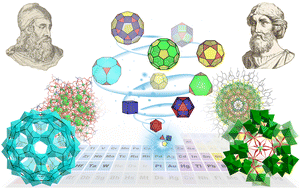Platonic and Archimedean solids in discrete metal-containing clusters
Abstract
Metal-containing clusters have attracted increasing attention over the past 2–3 decades. This intense interest can be attributed to the fact that these discrete metal aggregates, whose atomically precise structures are resolved by single-crystal X-ray diffraction (SCXRD), often possess intriguing geometrical features (high symmetry, aesthetically pleasing shapes and architectures) and fascinating physical properties, providing invaluable opportunities for the intersection of different disciplines including chemistry, physics, mathematical geometry and materials science. In this review, we attempt to reinterpret and connect these fascinating clusters from the perspective of Platonic and Archimedean solid characteristics, focusing on highly symmetrical and complex metal-containing (metal = Al, Ti, V, Mo, W, U, Mn, Fe, Co, Ni, Pd, Pt, Cu, Ag, Au, lanthanoids (Ln), and actinoids) high-nuclearity clusters, including metal-oxo/hydroxide/chalcogenide clusters and metal clusters (with metal–metal binding) protected by surface organic ligands, such as thiolate, phosphine, alkynyl, carbonyl and nitrogen/oxygen donor ligands. Furthermore, we present the symmetrical beauty of metal cluster structures and the geometrical similarity of different types of clusters and provide a large number of examples to show how to accurately describe the metal clusters from the perspective of highly symmetrical polyhedra. Finally, knowledge and further insights into the design and synthesis of unknown metal clusters are put forward by summarizing these “star” molecules.



 Please wait while we load your content...
Please wait while we load your content...